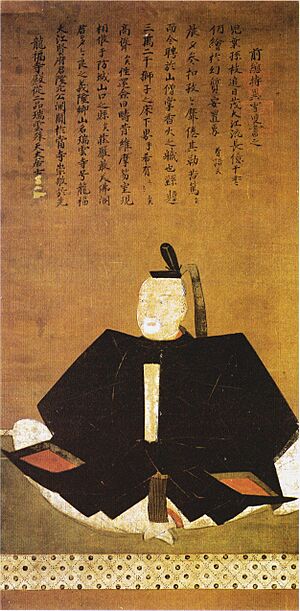Ōuchi Yoshitaka facts for kids
Quick facts for kids
Ōuchi Yoshitaka
|
|
|---|---|

Portrait of Ōuchi Yoshitaka
|
|
| Shugo daimyō of Suō, Nagato, Iwami, Buzen, and Chikuzen provinces | |
| Preceded by | Ōuchi Yoshioki |
| Succeeded by | Ōuchi Yoshinaga |
| Personal details | |
| Born | December 18, 1507 Yamaguchi, Japan |
| Died | September 30, 1551 (aged 43) Tainei-ji Temple, Nagato, Japan |
Ōuchi Yoshitaka (大内 義隆, December 18, 1507 – September 30, 1551) was a powerful Japanese lord, known as a daimyō. He led the Ōuchi clan and ruled over the Suō Province. He took over from his father, Ōuchi Yoshioki.
Contents
Early Life and Rise to Power
Ōuchi Yoshitaka was born on December 18, 1507. He grew up in a time when many powerful families in Japan were fighting for control.
Expanding His Territory
In 1522, Yoshitaka joined his father, Yoshioki, in battles against the Amago clan. Their goal was to control Aki Province. When his father passed away in 1528, Yoshitaka became the new leader of the Ōuchi clan.
During the 1530s, he led his armies into northern Kyūshū. He successfully defeated the Shōni clan and gained control of that area. With his lands secure, he once again focused on the Amago clan. By 1541, he had fully taken control of Aki Province.
A Change in Focus
In 1542, Yoshitaka tried to invade Izumo Province. This invasion ended badly for him. He lost many soldiers and his adopted son, Ōuchi Harumochi, in a battle against Amago Haruhisa. His attempt to capture Toda Castle in 1542–43 also failed.
After these losses, Yoshitaka decided to stop trying to expand his lands. Instead, he started spending his time on arts and culture. This change caused a split among his loyal followers, called retainers.
Two Different Ideas
One group of retainers, led by Sagara Taketō, believed the Ōuchi clan should just keep the lands they already had. They thought it was best to avoid more wars. Another group, led by Sue Harukata, wanted to keep fighting and expand the clan's territory. Yoshitaka agreed with Sagara Taketō's idea of keeping things peaceful.
A Time of Culture and Prosperity
Under Yoshitaka's leadership, foreign trade and the arts really grew. His home city, Yamaguchi, became very rich and important.
Welcoming New Ideas
Yoshitaka also welcomed the Portuguese missionary Francis Xavier. He allowed Xavier to share his Christian faith while in Yamaguchi. This showed Yoshitaka's open mind to new cultures and ideas.
Supporting the Emperor
At the same time, Yoshitaka built a strong relationship with Emperor Go-Nara in Kyoto. He helped pay for many important royal ceremonies. The emperor's court could not have afforded these events otherwise.
In 1551, the emperor faced problems from another powerful warlord, Miyoshi Nagayoshi. To get help, the emperor made Ōuchi Yoshitaka the Acting Governor of Yamashiro. This was the province where Kyoto, the capital city, was located. Yoshitaka, as the protector of the court, planned to move the emperor and his court to Yamaguchi. Many important people from the court, including former high-ranking officials, moved to Yamaguchi. By the end of August 1551, almost the entire court, except for the emperor himself, was in Yamaguchi.
The End of His Reign
The military leaders of the Ōuchi clan did not like Yoshitaka's new focus on culture and his plan to move the imperial court to Yamaguchi. They felt it made him seem weak and would reduce their own power.
The Revolt
In September 1551, the group led by Sue Harukata started a revolt. They wanted to take control of the Ōuchi clan. Since Harukata controlled the soldiers, the revolt was over in just a few days. The people from the imperial court were killed, and Yoshitaka was forced to end his own life at the Tainei-ji Temple in Nagato Province. Before he died, he wrote a special poem:
Both the victor
and the vanquished are
but drops of dew,
but bolts of lightning –
thus should we view the world.

